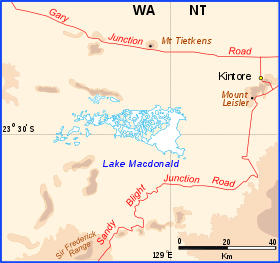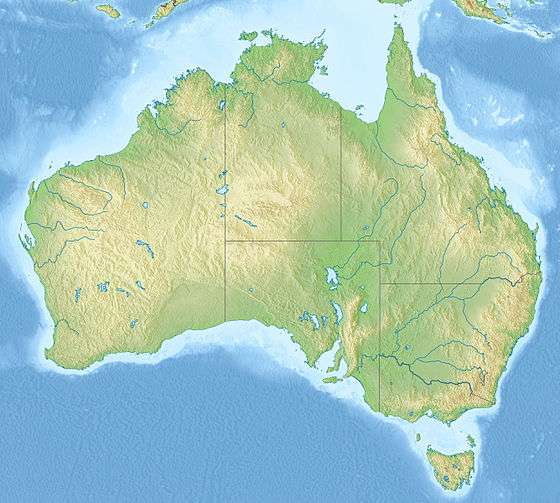Lake Macdonald
Lake Macdonald (in Pintupi dialect, Karrkurutinyja) is an ephemeral lake that straddles the border between Western Australia and the Northern Territory. It lies south of Lake Mackay, and south-west of Kintore, Northern Territory. Lying in country inhabited by Indigenous Australians for many thousands of years, it was first visited by Europeans in 1889, as part of an expedition supported by the Royal Geographical Society of South Australia. The expedition was led by William Tietkens; its activities included the first known photographs taken of Uluru.[1] The lake is named after the secretary of the Victorian branch of the Geographical Society at that time.[2] The area has been investigated for the mining of potash.[3]
| Lake Macdonald | |
|---|---|
 | |
 Lake Macdonald Location on the Northern Territory and Western Australian border | |
| Location | Western Australia and Northern Territory |
| Coordinates | 23°30′S 129°00′E |
| Type | Salt lake |
| Native name | Karrkurutinyja |
| Basin countries | Australia |
| Max. length | 58 km (36 mi) |
| Max. width | 23 km (14 mi) |
The lake marks the southern boundary of the Kiwirrkurra Indigenous Protected Area.[4]
The land around Karrkurutinyja was the birthplace of contemporary Indigenous Australian artists including Yala Yala Gibbs Tjungurrayi, Shorty Lungkarta Tjungurrayi[5] and Narputta Nangala, mother of Daisy Jugadai Napaltjarri.[6]
See also
References
- Hartwig, Mervyn (1976). "Tietkens, William Harry (1844 - 1933)". Australian Dictionary of Biography. Melbourne University Press. ISSN 1833-7538. Retrieved 30 March 2016 – via National Centre of Biography, Australian National University.
- "The RGS involvement in early exploration". Royal Geographical Society of South Australia. Retrieved 30 March 2016.
- "Lake MacDonald Potash Project, WA/NT". Rum Jungle Resources. Retrieved 30 March 2016.
- "Kiwirrkurra". Indigenous Protected Areas. Country Needs People. Retrieved 30 March 2016.
- "The artists". Papunya Painting: out of the desert. National Museum of Australia. Retrieved 30 March 2016.
- "Narputta Nangala". Tradition And Transformation: Indigenous Art in the NGV Collection. National Gallery of Victoria. Retrieved 30 March 2016.